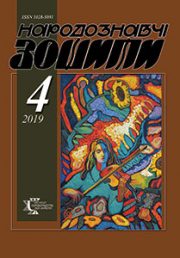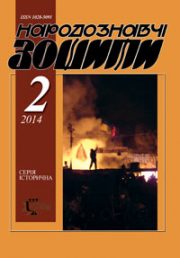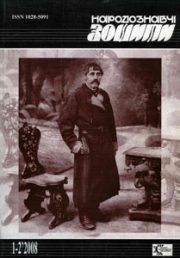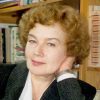The Ethnology Notebooks. 2024. № 2 (182), 281—294
UDK 75.071.046.3»15»(477.83-22)Вовча
DOI https://doi.org/10.15407/nz2025.02.281
HELYTOVYCH Maria
- ORCID ID: https://orcid.org/0000-0001-5839-9585
- Candidate of Arts, Associate Professor,
- Lead Researcher,
- Andrey Sheptytski National Museum in Lviv,
- 20, Svobody avenue, 79000, Lviv, Ukraine,
- Contacts: e-mail: helytovychm@yahoo.com
Abstract. This study presents for the first time a comprehensive overview of the renowned artistic legacy of an anonymous icon painter, conditionally referred to in literature as the «icon master from the village of Vovcha». Active in the Boykivshchyna region during the last quarter of the 16th century, the painter is proposed to be classified among the most original creative figures in Western Ukrainian painting of that epoch, representing its so-called folk line. His works provide vivid examples for characterizing the iconography of the time, particularly the transformations that Ukrainian icon painting underwent in the last quarter of the 16th century. The icons are systematically categorized by their place of origin and thematic content. Based on three dozen artifacts housed in museums across Ukraine, Poland, and Slovakia, the foundational characteristics of individual artistic expression, peculiarities of iconography, and thematic repertoire are traced. The works are examined within the context of one of the major stylistic trends of the second half of the 16th century to which they belong. The «Master of Icons from Vovcha» represents a segment of painting from the relatively few iconographers whose works retained ancient Byzantine traditions for the longest time. At the end of the 16th and the beginning of the 17th century, the search for new artistic expressions became evident in Ukrainian icon painting, oriented towards the new Western European artistic culture.
Keywords: icon, master, tradition, iconography, 16th century.
Received 7.04.2025
REFERENCES
- Sydor, O. (2000). Icons by the masters Oleksii and Dmytro in the collection of the National Museum in Lviv (materials for a compiled catalog of the NMU collections). Chronicle of the National Museum in Lviv (Pp. 89—152). Lviv [in Ukrainian].
- Helitovych, M. (1995). Fedusko, a painter from Sambir. On the problems of attributing the master’s works. Rodovid, 3 (12), 74—79 [in Ukrainian]
- Skop, L. (2011). The master of miniatures of the Peresopnytsia Gospel — Fedusko, a painter from Sambir. Drohobych: Kolo [in Ukrainian].
- Putsko, V. (1998). The icon of St. Nicholas of Myra by the painter Hryhorii Bosykovych from Suczawa. Notes of the Shevchenko Scientific Society. Works of the Commission on Fine and Applied Arts (Vol. CCCLXXXVI, pp. 373—397). Lviv [in Ukrainian].
- Aleksandrovych, V., & Mudryi, Maryan (Ed.). (1999). Fedor Senkovych (The life and creative journey of the Lviv painter of the early 17th century). Lviv: City — Society — Culture: Collection of scientific papers; Bulletin of Lviv University. Historical series. Special issue (Vol. 3, pp. 44—116). Lviv: Ivan Franko National University of Lviv [in Ukrainian].
- Vuytsyk, V. (1994). The fate of the icon «Praise to the Mother of God» from Ripneva. Rodovid, 8, 26—29 [in Ukrainian].
- Svyentsitska, V. (1967). Painting of the 14th—16th centuries. History of Ukrainian Art (Pp. 208—274). Kyiv [in Ukrainian].
- Patriarch Dmytrii (Yarema). (2005). Icon Painting of Western Ukraine in the 12th—15th centuries. Lviv: Druhkars’ki kunshty [in Ukrainian].
- Patriarch Dmytrii (Yarema). (2017). Icon Painting of Western Ukraine in the 16th to early 17th centuries. Lviv: Druhkars’ki kunshty [in Ukrainian].
- Skop, L. (1997). The author of the icon from Vovcha — a painter of the Sambir school of icon painting of the second half of the 16th century. History of Religions in Ukraine. Abstracts of the reports of the VII International Round Table (Lviv, May 12—14, 1997) (Pp. 168—170). Lviv [in Ukrainian].
- Skop, L. (2004). Painter of the icon of Mother of God-Odigitria from Mrazhnitsa. Lviv: Logos [in Ukrainian].
- Helytovych, M. (1999). Icons from the end of the 16th century from Vovcha. Rodovid, 1 (17), 32—37 [in Ukrainian].
- Helytovych, M. (1998). The Prayer from the Assumption Church in Nakonechne against the backdrop of the evolution of the Prayer rite in Western Ukrainian iconostases of the second half of the 16th century. Volyn Icon: Issues of History, Study, Research, and Restoration. Materials of the V Scientific Conference, Lutsk, August 27—28, 1998 (Pp. 72—78). Lutsk [in Ukrainian].
- Kudrytskyi, A.V. (Ed.). (1995). Art of Ukraine: Encyclopedia: in 5 vol. (Vol. 1: A—B). Kyiv: Ukrainian Encyclopedia named after M.P. Bazhan [in Ukrainian].
- Kosiv, R. (2009). Ukrainian Banners. Kyiv: Oranta [in Ukrainian].
- Svyentsitskyi-Svyatytskyi, I. (1929). Icons of Galician Ukraine of the 15th—16th centuries. Lviv [in Ukrainian].
- Gordynskyi, S. (1973). Ukrainian Icon from the 12th to the 18th Century. Philadelphia: Providence [in Ukrainian].
- Svyentsitska, V. (1996). «On the Problem of the Lviv School of Painting in the Second Half of the 16th Century». Collection «Science and Culture» (Issue 29, pp. 178—193). Kyiv [in Ukrainian].
- Svyentsitska, V.I., & Otkovych, V.P. (Eds.). (1991). Ukrainian Folk Painting of the 13th—20th Century: The World Through the Eyes of Folk Artists: Album. Kyiv: Mystetstvo [in Ukrainian].
- Miliayeva, L., & Helitovych, M. (2007). Ukrainian Icons of the 11th—18th Centuries. Kyiv [in Ukrainian].
- Helytovych, M. (2008). Saint Nicholas with Life. Lviv: Svyichado [in Ukrainian].
- Helytovych, M. (2004). «Icons from the Late 16th Century from the Trinity Church in the Village of Potelych». (Materials for the Catalog of the Collection of the National Museum in Lviv). Notes of the Shevchenko Scientific Society. Works of the Commission on Fine and Applied Arts (Vol. CCLXVIII, pp. 318—348). Lviv [in Ukrainian].
- Slobodian, V. (2003). Churches of the Turka District. Lviv [in Ukrainian].
- Webersfeld, E. (1909). Jaworow. Historical, Ethnographic, and Statistical Monograph. Lviv [in Polish].
- Helytovych, M. (2005). The Mother of God with Child and Praise. Lviv: Svyichado [in Ukrainian].
- Mokriyi, V., & Helytovych, M. (2013). «The Mother of God Odigitria from Krasiv in the Light of New Restoration Studies». Preservation and Research of Historical and Cultural Heritage in Museum Collections: Historical, Art, and Museological Aspects of Activity: Reports and Communications of the International Scientific Conference, Lviv, September 25—27, 2013); National Museum in Lviv named after A. Sheptytsky (Pp. 714—717). Lviv [in Ukrainian].
- Ovsiichuk, V. (1996). Ukrainian Painting from the 10th to the 18th Centuries: Problems of Color. Lviv [in Ukrainian].
- Jarema, W. (1972). «Primitive Iconostases in Wooden Churches of Subcarpathia». Materials of the Museum of Folk Architecture in Sanok, 16, 23—32 [in Polish].
- Svyentsitskyi, I. (1928). Iconography of Galicia Ukraine from the 15th to the 16th Centuries. Lviv [in Ukrainian].
- Skop-Druzyuk, H., & Skop, P. (2009). Iconostasis of the 16th—18th Century from the Village of Stara Skvaryava. Lviv: Logos [in Ukrainian].
- Winnicka, K. (2013). Icons from the 16th Century in the Historical Museum in Sanok. Collection Catalog (Vol. II). Sanok [in Polish].
- Sydorova, V.A., Borovaya, T.A., & Tseskovska, T.A. (Eds.). (1940). Exhibition of Visual Arts from the Western Regions of Ukraine and Folk Art of Hutsuls: Catalog. Moscow: State Museum of New Western Art [in Russian].
- Helytovych, M., & Mudryi, Marian (Ed.). (1999). The Icon «The Wounding with Attendants» from the Second Half of the 16th Century from the Church of the Prophet Elijah in Kryvchytsi». Lviv: City — Society — Culture: Collection of Scientific Papers; Bulletin of Lviv University. Historical Series. Special Issue (Vol. 3, pp. 32—43). Lviv: Lviv Ivan Franko National University [in Ukrainian].
- Tkac, S. (1980). Icons from the 16th to the 19th Century in Northeastern Slovakia. Bratislava: Tatran [in Polish].
- Biskpski, R. (2000). «Crucifixion from Owczar. An Icon from the Second Half of the 15th Century». Collection Catalog. Sanok: Historical Museum in Sanok [in Polish].
- Tyschenko, O.R. (1992). History of Decorative and Applied Arts in Ukraine (13th—18th Centuries): Educational Manual. Kyiv: Lybid [in Ukrainian].
- Krvavych, D. (1995). Iconography of Sophia — The Wisdom of God in Ukrainian Art». Ukrainian Sacred Art: Traditions, Present, Prospects. Materials of the Second International Scientific Conference (Lviv, April 21—22, 1994) (Pp. 25—33). Lviv [in Ukrainian].
- Skop, L. (2017). «Dating of Galician Icons from the 14th—16th Centuries: Notes on the Methodology of Attribution of Ukrainian Church Paintin». Drohobych: Kolo [in Ukrainian].
- Helytovych, M. (2013). «The Icon ‘The Assembly of the Blessed Virgin Mary’ from the Second Half of the 16th Century from Lopushanka». Bulletin of Lviv University. Art Series (Issue 12, pp. 184—192). Lviv [in Ukrainian].
- Lozynskyi, T. (Ed.). (2008). Ukrainian Art of the 15th—20th Centuries. From Private Collections. Kyiv: Oranta [in Ukrainian].
- Sydor, O., & Lozynskyi, T. (Eds.). (2003). Ancient Ukrainian Icon: From Private Collections, Kyiv: Rodovid [in Ukrainian].
- Svyentsitskyi, I., & Fedyuk, M. (Eds.). (1939). Exhibition of Galician Primitives from the 17th—19th Centuries: Catalog. Lviv [in Ukrainian].






